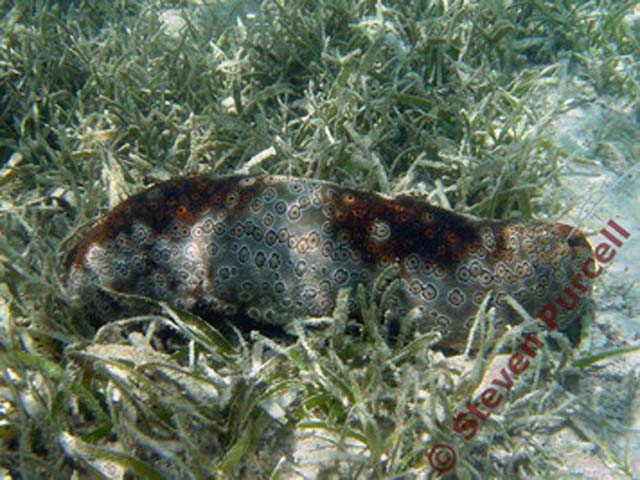| Holothuriidae (sea cucumbers) |
| 60 cm TL (male/unsexed); max.weight: 2,200.0 g |
|
reef-associated; marine; depth range 0 - 30 m |
| Indo-Pacific, including the Red Sea, but excluding Hawaii. |
|
Mean live weight: 1,800 g up to 2,200 g. Body-wall thickness: 0.1 cm. Body cylindrical, arched dorsally (bivium) and the flattened ventrally (trivium). Bivium smooth. Podia on bivium small, conical , and irregularly arranged; podia on trivium numerous, short, and arranged on the radii and interradii; calcareous disc of podia around 400 micrometer in diameter. Mouth ventral, surrounded by 20 short, dark tentacles. Anus nearly dorsal, surrounded by 5 groups of papillae. Calcareous ring with large radial pieces and narrow interradials. Cuvierian tubules numerous; large. Bivium whitish to brown, variable among specimens and showing characteristics dark eye-like some specimens uniformly brown with yellow spots. Spicules on ventral tegument with various simple rosettes and biscuit-like nodules, occasionally with small hole; dorsal tegument with rosettes only; ventral podia with short rods; dorsal podia with x-shaped rods; tentacles with spiny rods and large irregular plates. |
| Populations never reach high densities (generally between 0.001 and 0.01 per square meter). Occasionally collected by divers in artisanal fisheries, although the sticky Cuvierian tubules make the collection and processing disagreeable. Processed product is not distinguished from those of other Bohadschia species; little commercial value. Found in shallow waters; a typical reef species, generally on barrier reef flats and slopes, or outer lagoons on white sand (Ref. 122). On coarse sand near reef structures. Capable of burrowing into upper sediments (Ref. 92930). Symbiotic pearlfish (Carapidae, Ophidiiformes) are often found in the respiratory tree or the general cavity (Ref. 122). |
|
(LC); Date assessed: 18 May 2010 Ref. 123251)
|
| harmless |
|
Source and more info: www.sealifebase.org. For personal, classroom, and other internal use only. Not for publication.

